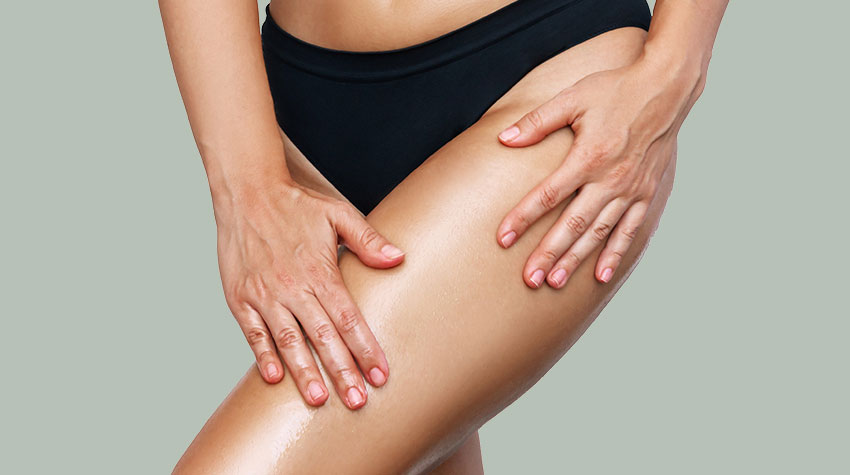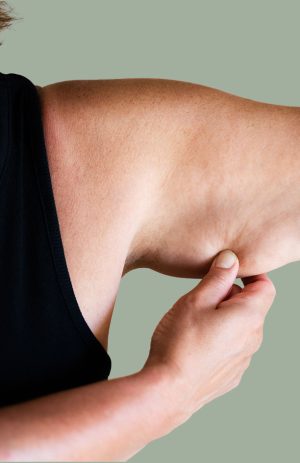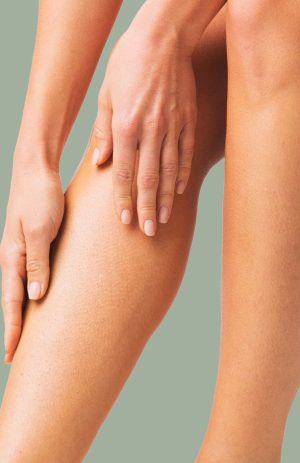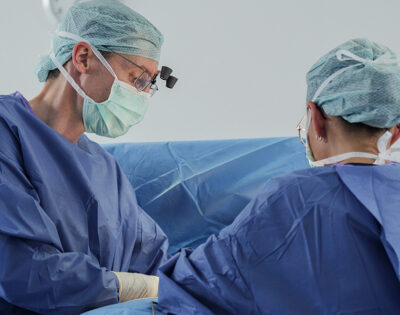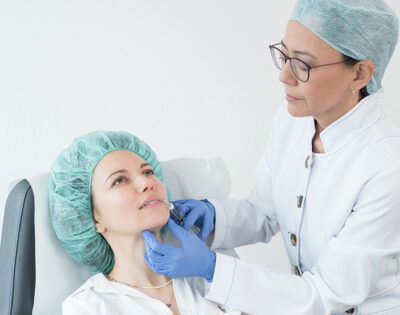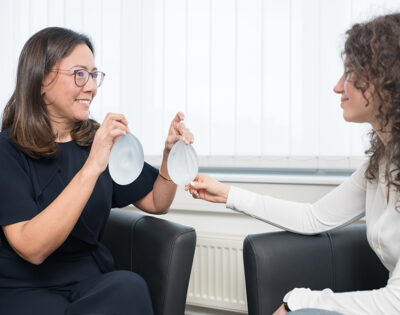Firm and rejuvenated thighs in Saarbrücken
The skin, fatty tissue and connective tissue of the thighs and buttocks change in women as they enter adulthood. Depending on the incidence of light, dents can be seen on the surface of the skin: a first sign of cellulite, also known as orange peel skin. Weight gain in women is usually accompanied by an increase in the circumference of the thighs and hips. The desire for rejuvenated, firm thighs arises.
The skin on the inner thighs is thin and inelastic and, in contrast to the outer thighs, does not have good connective tissue anchoring. Sagging or drooping skin on the thighs can spoil the joy of losing a lot of weight and achieving the desired slim legs. What’s more, hanging skin flaps can be psychologically stressful. Those affected are severely restricted in their choice of clothing and want their firm skin back.
The skin flaps on the thighs interfere with personal hygiene, leisure activities and sex life 1 . A surgical technique for tightening the thighs, the thigh lift, was described as early as 1957 2 . Since then, the surgical procedure has been continuously improved. Technical developments include, for example, a suturing technique developed by the Brazilian plastic surgeon Pitanguy and the combination with liposuction 3 4 . It has been shown that thigh lifts improve the quality of life of patients who have lost a lot of weight 5 . It is estimated that over 93,000 thigh lifts were performed worldwide in 2019 6 .
What our patients say
Information at a glance
Operation duration
3 hours
Aftercare
6 weeks
Anesthesia
Twilight sleep
Thread tension
Self-dissolving threads
Hospitalization
Outpatient
Socially acceptable
after 5 days
Costs
Additions or alternatives

Thigh lift abroad?
More and more patients in Germany are looking for more cost-effective options for leg lift surgery, e.g. in Istanbul, Prague or Budapest. It is not uncommon to come across dubious offers and neglect important criteria with regard to possible complications and optimal aftercare. Foreign practices lure unsuspecting patients via social media, among other things, by emphasizing low prices. The unrealistic advertising promises and exaggerated discounts offered are punishable under German law.
In Germany, it is a legal requirement that a specialist informs the patient. In the case of the aforementioned treatments abroad, it is not uncommon for a semi-skilled assistant to provide information via video consultation. In addition, possible complications are not adequately discussed.
One indicator of dubiousness is that the qualifications and experience of the surgeons are generally not mentioned on the websites. Facilities with a high incidence of complications or even deaths can be renamed to cover their tracks 7 .
However, in some cases complications occur after returning home, meaning that follow-up treatment in Germany can be expensive and lengthy. The most common complications of patients returning from abroad are wound healing disorders, inflammation, bruising and an unsatisfactory result. The surgeon who treated you abroad can often no longer be found. This means that you no longer have access to important documents relating to the original treatment, such as the surgical report, discharge letter or implant ID card. Most patients did not consider these problems and the resulting follow-up costs before treatment because they were tempted by the low price.
Procedure for a thigh lift

Preparation
- The tightening should be carried out when the desired weight has been reached.
- Keep nicotine and alcohol consumption to a minimum!
- The intake of hormone-containing medication (pill) may have to be temporarily discontinued.
- Blood-thinning medication should be avoided ten days before the operation after consultation with your doctor.
- Vitamin preparations (A, E) and dietary supplements (omega-3 fatty acids, St. John’s wort preparations, etc.) should be discontinued four weeks before the operation.
- Avoid air travel for business and pleasure for the first three to four weeks after the operation.
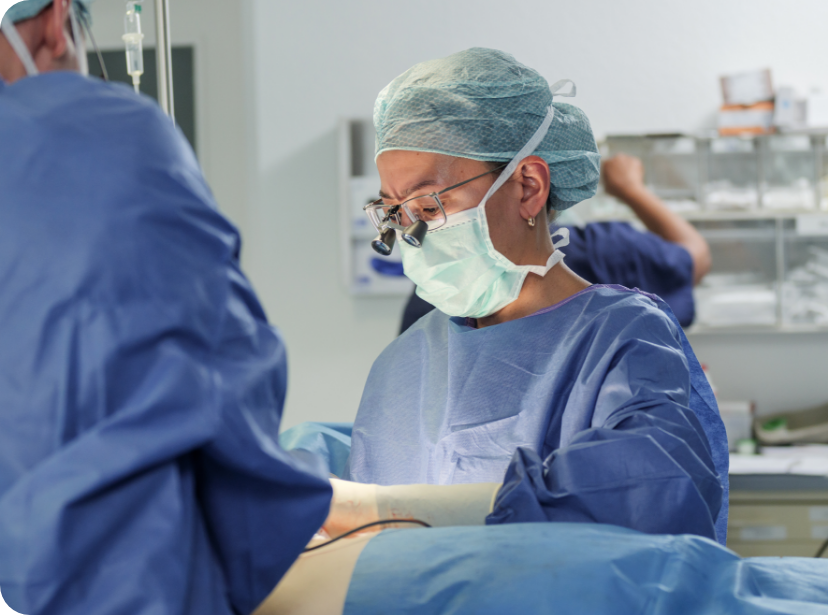
The OP
You should not have eaten or drunk anything in the last six to eight hours before the operation. Before the operation, your aesthetic plastic surgeon will welcome you to the clinic or practice. Your doctor will make markings on the skin of the thighs to carry out the discussed surgical plan. The anesthesiologist will then ensure that common questions and all your individual questions about the anesthesia procedure have been answered. The entire surgical team routinely checks that everything is prepared for your safety.
While you sleep peacefully, the entire surgical team will be concentrating on the implementation of your treatment plan. After the operation, we make sure that you have everything you need. After a short time you will be able to drink or eat something. Your cosmetic surgeon will discuss all the details of this cosmetic plastic surgery procedure with you and offer you appointments to review the healing process. You will receive a detailed report with the recommended behavioral measures and the personal telephone number of your doctor.
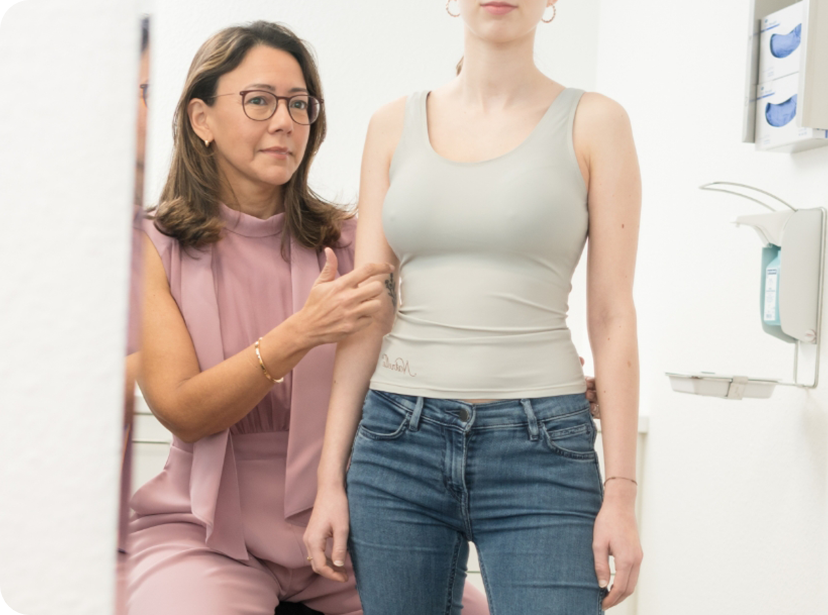
After the procedure
Optimal aftercare is also required for a perfect result. This ensures that the healing process progresses safely and quickly and that the desired good results are achieved early on. Please note the following recommendations:
- Monitoring the healing process in the first fourteen days ensures that any undesirable progression is recognized and averted in good time.
- The wound is largely closed by the third postoperative day. Showering ensures that the skin is freed from germs. Do not allow the wound to soak. Use a skin-friendly washing lotion and a clean towel after showering.
- Wearing a compression garment for the first six weeks helps the swelling to subside and healing to take place.
- From the third week onwards, you can support scar healing with massage and silicone plasters.
- In order not to disturb the healing process, you should avoid sport, swimming, heavy work and sunbathing for the first four weeks.
Methods of thigh lift
In the thigh lift plastic surgery procedure, excess skin is removed from the inner thighs. The additional suction of excess fatty tissue reduces the circumference and contributes to the creation of smaller and finer, barely visible scars. Various surgical methods have been developed with the aim of achieving an inconspicuous scar and an optimal tightening effect. Each technique has its advantages and disadvantages. The techniques are subdivided according to the course of the incision. The incision is the course of the surgical skin incision. It determines where and how much excess tissue and skin is removed. This determines where the later scar will be located. The key to an optimal result lies in the selection of the surgical method that is individually indicated for you.
Horizontal cut:
This technique is sometimes referred to as a small or mini thigh lift. The incision runs from the groin to the gluteal fold. A similar technique is used on the buttocks to tighten the so-called banana fold under the buttocks: the lower buttock lift. The mini thigh lift is suitable for correcting excess tissue in the inner thigh region close to the body. The decisive advantage of this technique is that the scar in the crotch is barely visible 8 . Liposuction and a special suturing technique help to create a harmonious transition from the thighs to the genital area 9 .
Vertical cut:
This method involves removing the sagging skin along the inside of the thighs. The operation is suitable for removing severely sagging skin on the entire thigh. This technique is therefore mainly used for major weight loss, such as after gastric sleeve surgery. The technique, which was described as early as 1957, is also erroneously referred to as the Aly thigh lift 10 11 12 .
Horizontal and vertical cut:
The combination of horizontal and vertical tightening enables maximum tightening. One way to achieve this is the so-called T-cut technique. The T-incision technique combines the mini thigh lift with the vertical tightening method. At the point where the scars meet on the inside of the thigh, the skin is very thin. Wound healing disorders may therefore occasionally occur at this point 13 . To avoid this, we prefer the gentler L-cut technique. The excess skin is removed in an L-shape on the inside of the thighs. The L-cut technique allows a very effective tightening and is considered safer than the T-cut technique 14 .
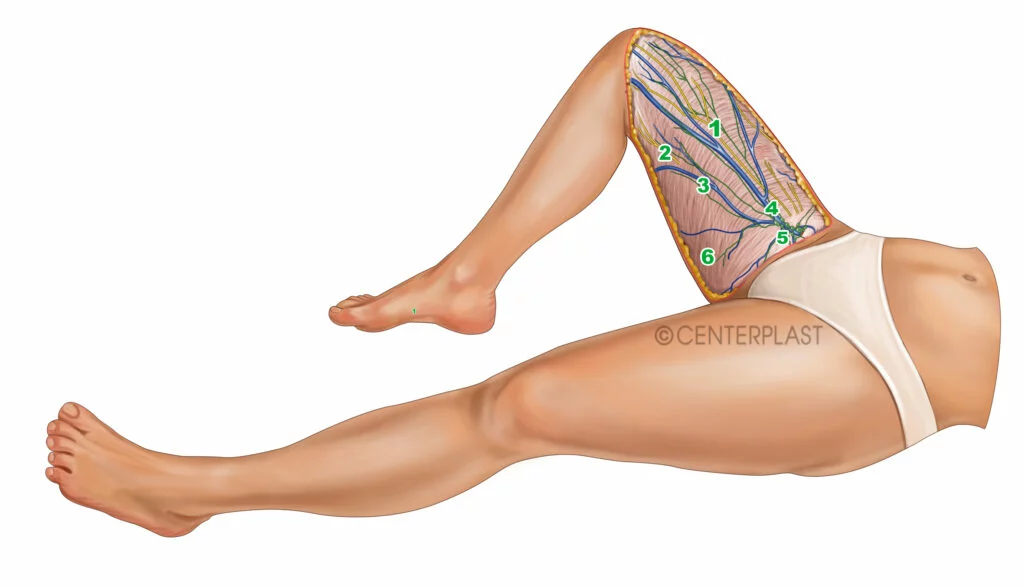
During a thigh lift, the subcutaneous fatty tissue is also reduced and sagging skin is removed. Unsightly pads that get in the way when walking can be removed. Gentle liposuction (SAFE Lipo, vibratory liposuction) preserves the lymphatic vessels. Special sutures are used to keep the skin sheath taut. These sutures prevent the skin and scar from sagging. The fixation of the connective tissue layer on the pubic bone prevents the transfer of tension to the wound or the vagina.
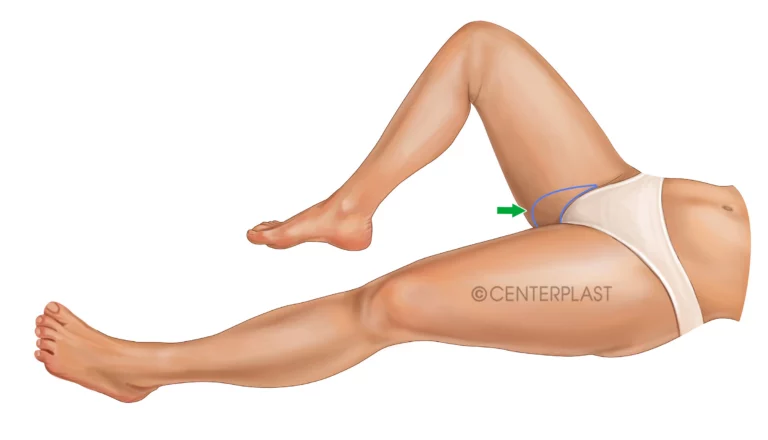
Region of excess skin that is removed during a mini thigh lift. The horizontal thigh lift leaves a particularly inconspicuous and short scar in the groin. The effect of a mini thigh lift can be enhanced with liposuction.
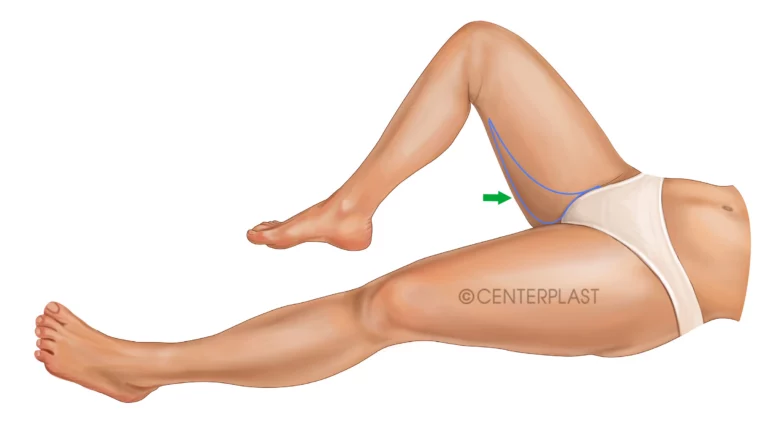
Region of excess skin that is removed during an L-shaped thigh lift. The L-shaped thigh lift enables effective tightening of the skin up to above the knee. Gentle liposuction (SAFE Lipo, vibratory liposuction) preserves the lymphatic vessels. Special sutures are used to keep the skin sheath taut. These sutures prevent the skin and scar from sagging. The fixation of the connective tissue layer on the pubic bone prevents the transfer of tension to the wound or the vagina.
Thigh lift without surgery
Even though there is some positive experience with non-invasive or minimally invasive methods, the benefits of laser, radiofrequency, ultrasound and thread lifting for thigh lifts have not yet been scientifically proven. There is also no scientific evidence for the effect of cellulite creams, extensive training in the form of specific, supposedly effective exercises for the thighs, compression stockings or alternating showers (Kneipp treatments). Cosmetic products, cosmetic devices, wellness offers and medical products are not legally obliged to prove an effect. Advertising and advertising claims are also barely regulated. The more exaggerated the claims for a quick result in the digital media, the greater the curiosity of consumers often is. Unfortunately, disproving a false statement is often more difficult than proving a true statement.
Experience reports thigh lift
How do I find a good, experienced specialist, i.e. a suitable cosmetic surgery specialist for my thigh lift? Patients often ask themselves this question when they want this aesthetic procedure. The usual way is to search for the relevant doctors in your own region in conjunction with patient experiences and reviews that can be found online. This is primarily done by looking at Google reviews and doctor ratings on Jameda or similar sites. We have bundled this information about our practice and doctors on the testimonials page. In addition to the reviews and testimonials, you will also find excerpts from interviews with our patients in a video.
What are the risks of a thigh lift?
Liposuction and simultaneous thigh lift is a safe procedure 15 . Complications are less common in non-smokers and in people with a body mass index of 25 16 . Smoking cessation and weight loss through a moderate and healthy diet should be considered where appropriate so that your treatments can take place in the best possible circumstances.
Combining a thigh lift with a breast lift or buttock lift?
After losing a lot of weight, sagging skin usually remains on several parts of the body. The combination with other cosmetic surgeries such as a tightening of several body regions (buttocks, abdomen, legs, arms) at the same time saves time and money. Since every procedure is associated with opportunities, but also risks, we put your safety first. The risks of an operation are influenced by your state of health and the extent of the operation. To put it simply, an operation lasting one hour carries fewer risks than an operation lasting eight hours. We are therefore endeavoring to limit the duration to six hours. As many other factors affect the risk, there is no generally valid limit value. Whether it is possible to tighten several areas of the body in the six-hour time frame depends on the areas affected. If you have a lot of excess fat tissue and skin, it may be advisable to have your legs, bottom and breasts tightened on two separate occasions for your own safety.
FAQ – Frequently asked questions
- The operation can be performed under general anesthesia or twilight sleep in combination with a local anesthetic.
- Thread pulling is not necessary as self-dissolving threads are used.
- The surgical procedure takes 2 to 3 hours, depending on the findings.
You can easily find out the costs of a thigh lift in a personal consultation with us.
The costs of a thigh lift are not usually covered by health insurance. You can find more information on our page Obligation of health insurance companies to provide benefits.
You don’t want to wait until you have painstakingly saved up the money for a thigh lift? We would be happy to provide you with detailed information about existing financing options for your cosmetic surgery for skin tightening for beautiful, firm legs in a personal consultation. You can also find out more about the topic in advance on our website.

AUTHOR
Dr. Stéphane Stahl
We provide you with extensive expert knowledge in order to select the best possible treatment path together with you.
Privatdozent Dr. med. Stéphane Stahl is the former Director of the Clinic for Plastic, Reconstructive and Aesthetic Surgery / Hand Surgery at Lüdenscheid Hospital. Dr. Stahl studied medicine at the Universities of Freiburg and Berlin.
He passed the European specialist examination for plastic and aesthetic surgery in 2011 and the German specialist examination in 2012. This was followed by further specialist qualifications and additional qualifications (including quality management, medical didactics, physical therapy, emergency medicine, laser protection officer, hand surgery) as well as prizes and awards.
In 2015, he completed his habilitation in plastic and aesthetic surgery in Tübingen. He is an experienced microsurgeon, sought-after expert witness and regular speaker at specialist congresses. Following a multi-stage selection process, Stéphane Stahl became a member of the American Society for Aesthetic Plastic Surgery (ASAPS), one of the world’s largest and most influential specialist societies for aesthetic surgery.
His authorship includes numerous articles in prestigious peer review journals and standard surgical textbooks.
- Chandawarkar R.Y., 2006. Adv Psychosom Med. ↩︎
- Lewis Jr., 1957, J Int Coll Surg. ↩︎
- Pitanguy I., 1971, Surg Clin North Am ↩︎
- Lockwood T.E., 1988, Plast Reconstr Surg. ↩︎
- Mocquard C, Pluvy I, Chaput B, et al. 2021, Obes Surg. ↩︎
- ISAPS Statistik 2019 ↩︎
- Venditto C, et al. 2020, Aesthet Surg J. ↩︎
- Schultz R.C., Feinberg L.A., 1979, Ann Plast Surg ↩︎
- Lockwood T.E., 1988, Plast Reconstr Surg. ↩︎
- Lewis Jr. 1957. J Int Coll Surg. ↩︎
- Cram A, Aly A., 2008, Clin Plast Surg. ↩︎
- Michaels J., 2019, Clin Plast Surg. ↩︎
- Gusenoff JA, Coon D, Nayar H, et al., 2015, Plast Reconstr Surg. ↩︎
- Bracaglia R, Tambasco D, et al., 2015, Ann Plast Surg. ↩︎
- Di Pietro V, Gianfranco MC, Cervelli V, et al., 2019,World J Plast Surg ↩︎
- Kühn S, Klettenheimer A, Küenzlen L, Kiehlmann M, et al. 2019, J Cutan Aesthet Surg. ↩︎
You might also be interested in

Personal advice
We take time for you and offer you customized advice and treatment for your individual result.
